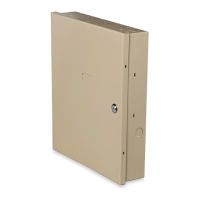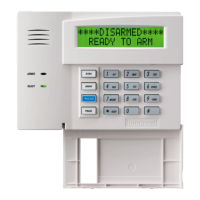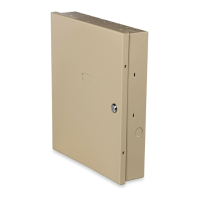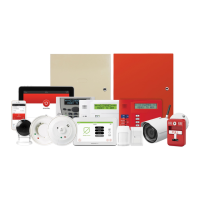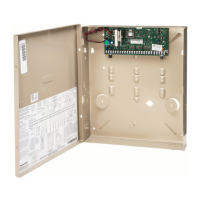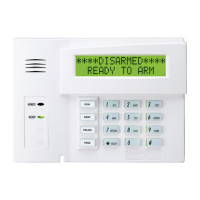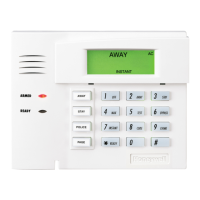
Do you have a question about the Honeywell ADEMCO VISTA-20PSIA and is the answer not in the manual?
| Maximum Zones | 48 |
|---|---|
| Hardwired Zones | 8 |
| Wireless Zones | 40 |
| Partitions | 2 |
| User Codes | 48 |
| Communication | Cellular, IP |
| Battery Backup | 12V 7Ah |
| Dimensions | 12.5 x 10.5 x 3 inches |
| Operating Temperature | 0°C to 49°C (32°F to 120°F) |
| Type | Wired/Wireless Hybrid Security System |
Provides an overview of the Honeywell security system's capabilities and benefits.
Details the fundamental protection types: burglary, fire, and security codes.
Explains how system zones and partitions provide areas of protection.
Covers methods for arming and disarming the burglary protection features.
Describes how alarms are indicated and handled by the system.
Explains how alarm events are stored and displayed on the keypad.
Details how to access the system remotely via a phone module.
Describes the programmable 'A', 'B', 'C', 'D' keys and their functions.
Explains the system's ability to send condition messages to pagers.
Covers the system's capability to automate functions based on time schedules.
Instructions for recording and playing messages on voice-capable keypads.
Provides an overview of keypad features including display, sounder, and backlighting.
Details the Fixed-Word display keypad, its functions and indicators.
Explains the time allowed to disarm the system after entering through a designated door.
Describes the time allowed to leave the premises after arming the system.
Covers the feature to restart the exit delay if needed.
Details conditions that trigger an exit alarm and how to clear them.
Explains specific scenarios causing exit errors and their resolution.
Describes the 'Recent Closing' status for specific models and its implications.
Instructs on using the [*] key to check zone status before arming.
Explains how voice keypads announce system status and faulted zones.
Arms perimeter sensors only, with entry delay active.
Arms perimeter and selected interior zones, with entry delay.
Arms perimeter sensors only, without entry delay.
Arms all sensors (perimeter and interior) with entry delay.
Arms all sensors without entry delay.
Details the key sequences required to arm the system in various modes.
Explains arming the system without a security code if programmed.
Describes arming the system using programmed function keys.
Covers arming the system with a single programmed function key.
Explains step-arming functionality assigned to a single key.
Details how to use a keyswitch for arming and disarming the system.
Explains how to disarm the system, silence alarms, and clear memories.
Covers bypassing specific zones to leave them unprotected when arming.
Describes 'vent zones' that are automatically bypassed when open.
Explains bypassing all open zones automatically with a single command.
Enables audible alerts for door/window openings when the system is disarmed.
Describes voice announcements for zone openings with voice keypads.
Details how to display the system's current date and time on an alpha keypad.
Provides instructions for setting the system's date and time.
Explains how to manually initiate emergency alarms using programmed keys.
Introduces macro keys for automating sequences of up to 16 keystrokes.
Illustrates programming a macro sequence with a practical example.
Details how to activate a previously programmed macro sequence.
Explains how to control connected devices like lights using system commands.
Covers the system's ability to automatically send status messages to pagers.
Describes how to manually send messages to pagers.
Explains a feature for notifying pagers if scheduled events don't occur.
Explains the master code and other user security codes and their roles.
Defines the different authority levels and the system functions they permit.
Details the command strings for adding security codes and user attributes.
Explains how users can perform functions in partitions other than their default.
Details using the GoTo command to switch between partitions.
Covers arming multiple partitions simultaneously.
Lists the commands for arming all partitions in various modes.
Explains the functionality and behavior of a common zone shared by partitions.
Introduces the system's end-user schedule programming for event control.
Provides step-by-step instructions for creating new schedules.
Explains the system's event history log and how it stores events.
Details how to access and navigate the system's event log.
Explains the codes and formats used to display event types in the log.
Covers the importance and procedure for weekly system testing.
Explains the meaning of 'CHECK' and 'BATTERY' messages on the keypad.
Describes various other trouble messages and their causes.
Details the system's behavior and actions for a total power failure.
Provides guidance for troubleshooting telephone line issues.
Outlines basic maintenance steps to ensure system reliability.
Explains how to silence low battery warnings and what they signify.
Provides guidance on replacing batteries in wireless sensors.
Offers advice on general care and cleaning of system components.
Describes the residential fire alarm system's operation and emergency signals.
Details how to silence fire alarms and clear the display.
Explains the procedure for resetting smoke detectors after an alarm.
Covers the process of manually triggering a fire alarm.
Explains how to use specific keys for manual fire alarm activation.
Presents NFPA guidelines for the number and placement of smoke detectors.
Provides recommendations for establishing and practicing fire escape plans.
Summarizes audible and visual notifications for Fixed-Word display keypads.
Summarizes audible and visual notifications for Alpha display keypads.
Contains FCC statements regarding radio frequency energy and interference.
Details FCC requirements for telephone/modem interface compliance.
Provides Industry Canada certification and notices for telecommunications equipment.
Explains the Ringer Equivalence Number (REN) and terminal connection limits.
Lists key system features and their operational comments.
Details the programming and functionality of system function keys.
Provides a log for tracking system user numbers, codes, and attributes.
Details the setup for configuring pager phone numbers and reporting events.
Provides a log for recording programmed schedules and their parameters.
Lists programmable output devices and their associated schedules/keys.
Section for basic insured and insurance company details.
Details notification contacts for burglary and fire events.
Indicates the system's power source, typically AC with rechargeable supply.
Specifies the frequency of system testing (quarterly, monthly, etc.).
Lists various locations for smoke detector installation.
Lists typical locations for burglary detection devices.
A free-form section for any other relevant system information.
